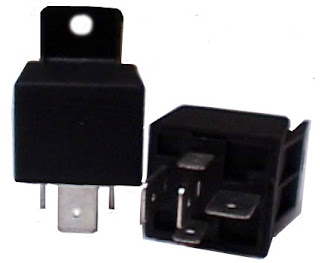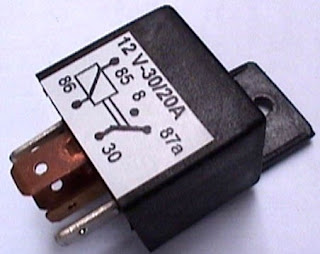 http://www.fourthgen.net/Guaranteed Products, Low Prices, Free Shipping Worldwide
http://www.fourthgen.net/Guaranteed Products, Low Prices, Free Shipping WorldwideRelay – What is a Relay , Why is it required & How can it be used?
70 amp 5 Pin (SPDT) Relays
What is a Relay?
A relay is an electromechanical or electronic device through which a heavy load can be switched ON & OFF with a nominal input of current & voltage. We will discuss on the Electromechanical Relay used in automotive applications.
The utility and the function can be best understood from the application of a lever to shift a heavy load. A lever is inserted at a corner of a heavy load and by placing a fulcrum (wedge) under the lever, the heavy load is easily lifted by one person. Similarly, a heavy electrical load drawing heavy current can be switched ON & OFF by applying a small amount of current through a Coil(Solenoid). The Coil gets magnetized with the current and attracts or repels a Plunger(a rod passed through the coil) . That attraction or repelling of the Plunger with the current, either connects two Switching Contacts (NO or Normally Open/Single Throw/Form A) or separates them (NC or Normally Closed/Double Throw/Form C), as required, to pass the heavy current through the contacts. As soon as the energisation of the Coil is stopped the main contacts go back to their original position.
Therefore, in an Electrical & Electronic circuit or device a Relay is essentially required for switching on or off or other specially designed functions. In automobile applications Relays of different configurations with single or multiple contacts are used for different applications in the functioning of an automobile.
Why is the Relay required?
Apart from switching a circuit with heavy load, ON & OFF, a relay is required to
2. Prolong the life of device
3. Improve the efficiency of a device.
For example let us take the switching of two headlamps of an automobile or a boat. If the same is switched ON through a normal switch at the dashboard, the voltage drop from the battery to the lamps through the switch will be enormous and the heat generated in the circuit due to resistance will be considerable. If the voltage drops, the heavy current will be drawn by the lamps as per their wattage as per Ohms Law. This will not only heat the circuit but also drain the battery heavily.
To give an example of the effect of voltage drop, a chart is given below:
Operating Voltage. Luminous Intensity of a Lamp.
100% 100%
95% 83%
90% 67%
85% 53%
To switch on a 12V-60/100 Watt Halogen lamp, a typical 12V Relay allows a voltage drop of only 0.02V and the Coil Current is only 2 Milliamps.
Another important function of the relay is quick switching OFF(0.05Sec Max.). The more time the contacts of a switch take to break at full load, the more sparks will be generated due to electromagnetic effect on contacts in switched state. Prolonged sparking will mean more wear of contact points and the danger of contacts melting and generating a fire. The Automotive Relay specifications are very stringent in SAE/DIN/VDE/JIS/BIS etc international standards. The endurance of a Relay is generally specified in millions of switching operations.
The Relay is applied to various switching and safety circuits in an automobile.
How & where a Relay should be used:
Wherever manual switching has been used for direct switching of a Lamp or Motor or any
70 Amp 4 Pin (SPST) Relays
gadget exceeding 10 Amps of load, a suitable Relay must be put in the circuit. It will better if
a. The relay can be kept as near as possible to the load (but not in a hot area surrounding near the engine)
b. Wires connected to the manual switch should be connected to any Coil terminal of the Relay
c. The load should be connected to any one contact terminal of the Relay (unless Positive/Negative are specified) and the other to the positive terminal of the battery (for Negative Ground circuit), with an appropriate Fuse.
For more information on the various types of Relays and their configuration, please visit
www.fourthgen.net
A Relay must be used in an automobile electrical circuit wherever a Resistive(Lamp) or Inductive(Motor/Solenoid) load is to be switched or interlocked. A basic Relay is specified by DC Voltage of the Coil, AC or DC Voltage of the Switching Contacts, Ampere of the DC/AC load the contacts can take continuously, Configuration of operation & Special construction.
In configuration , two basic operations are specified, i.e Normally Open(NO) or 1(contact point) Form A or Single Pole Single Throw(SPST) and Normally Open + Normally Closed(NO+NC), 1 Form B or Single Pole Double Throw(SPDT). There are various sizes, combination of switching contacts, with or without , freewheeling prevention Resistance/Diode, Built in circuitry etc.










